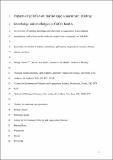Files in this item
Impacts of jellyfish on marine cage aquaculture : an overview of existing knowledge and the challenges to finfish health
Item metadata
| dc.contributor.author | Clinton, Morag | |
| dc.contributor.author | Ferrier, David E K | |
| dc.contributor.author | Martin, Samuel A M | |
| dc.contributor.author | Brierley, Andrew S | |
| dc.date.accessioned | 2022-04-01T23:43:49Z | |
| dc.date.available | 2022-04-01T23:43:49Z | |
| dc.date.issued | 2021-08 | |
| dc.identifier | 273831848 | |
| dc.identifier | 5bde849b-d028-49a7-a3ae-47554e7b28c8 | |
| dc.identifier | 000696576500001 | |
| dc.identifier | 85116218301 | |
| dc.identifier.citation | Clinton , M , Ferrier , D E K , Martin , S A M & Brierley , A S 2021 , ' Impacts of jellyfish on marine cage aquaculture : an overview of existing knowledge and the challenges to finfish health ' , ICES Journal of Marine Science , vol. 78 , no. 5 , pp. 1557–1573 . https://doi.org/10.1093/icesjms/fsaa254 | en |
| dc.identifier.issn | 1054-3139 | |
| dc.identifier.other | Jisc: 66b93832f7b74bfca5d6ed8c39076bc1 | |
| dc.identifier.uri | https://hdl.handle.net/10023/25136 | |
| dc.description | BBSRC Eastbio funded studentship (lead author). | en |
| dc.description.abstract | Gelatinous plankton present a challenge to marine fish aquaculture that remains to be addressed. Shifting plankton distributions, suggested by some to be a result of factors such as climate change and overfishing, appear to be exacerbated by anthropogenic factors linked directly to aquaculture. Fish health can be negatively influenced by exposure to the cnidarian hydrozoan and scyphozoan life stages commonly referred to as “jellyfish”. Impact is particularly pronounced in gill tissue, where three key outcomes of exposure are described; direct traumatic damage, impaired function, and initiation of secondary disease. Cnidarian jellyfish demonstrated to negatively impact fish include Cyanea capillata, Aurelia aurita, and Pelagia noctiluca. Further coelenterates have also been associated with harm to fish, including sessile polyps of species such as Ectopleura larynx. An accurate picture of inshore planktic exposure densities within the coastal environments of aquaculture would aid in understanding cnidarian species of concern, and their impact upon fish health, particularly in gill disease. This information is however presently lacking. This review summarises the available literature regarding the impact of gelatinous plankton on finfish aquaculture, with a focus on cnidarian impact on fish health. Present strategies in monitoring and mitigation are presented, alongside identified critical knowledge gaps. | |
| dc.format.extent | 54681354 | |
| dc.language.iso | eng | |
| dc.relation.ispartof | ICES Journal of Marine Science | en |
| dc.subject | Ecology | en |
| dc.subject | Aquatic Science | en |
| dc.subject | Ecology, Evolution, Behavior and Systematics | en |
| dc.subject | Oceanography | en |
| dc.subject | GC Oceanography | en |
| dc.subject | SH Aquaculture. Fisheries. Angling | en |
| dc.subject | SDG 13 - Climate Action | en |
| dc.subject | SDG 14 - Life Below Water | en |
| dc.subject | AC | en |
| dc.subject.lcc | GC | en |
| dc.subject.lcc | SH | en |
| dc.title | Impacts of jellyfish on marine cage aquaculture : an overview of existing knowledge and the challenges to finfish health | en |
| dc.type | Journal item | en |
| dc.contributor.institution | University of St Andrews. Scottish Oceans Institute | en |
| dc.contributor.institution | University of St Andrews. School of Biology | en |
| dc.contributor.institution | University of St Andrews. Centre for Biophotonics | en |
| dc.contributor.institution | University of St Andrews. Marine Alliance for Science & Technology Scotland | en |
| dc.contributor.institution | University of St Andrews. St Andrews Bioinformatics Unit | en |
| dc.contributor.institution | University of St Andrews. Centre for Research into Ecological & Environmental Modelling | en |
| dc.contributor.institution | University of St Andrews. Pelagic Ecology Research Group | en |
| dc.identifier.doi | 10.1093/icesjms/fsaa254 | |
| dc.description.status | Peer reviewed | en |
| dc.date.embargoedUntil | 2022-04-02 |
This item appears in the following Collection(s)
Items in the St Andrews Research Repository are protected by copyright, with all rights reserved, unless otherwise indicated.

